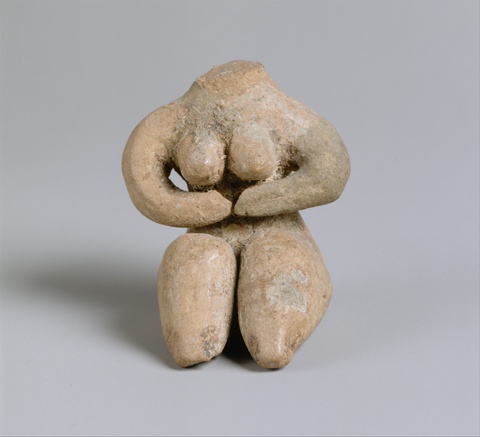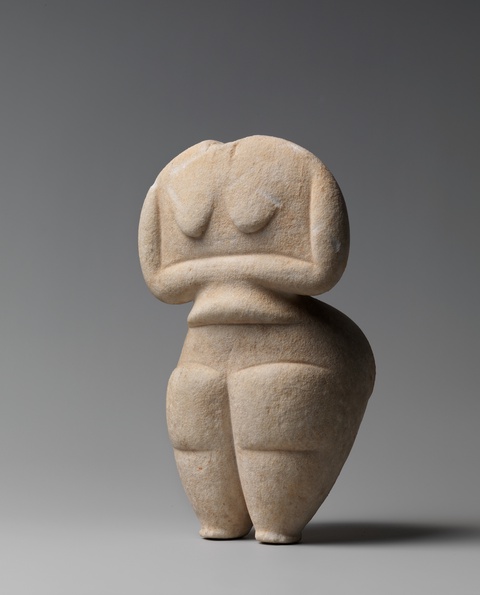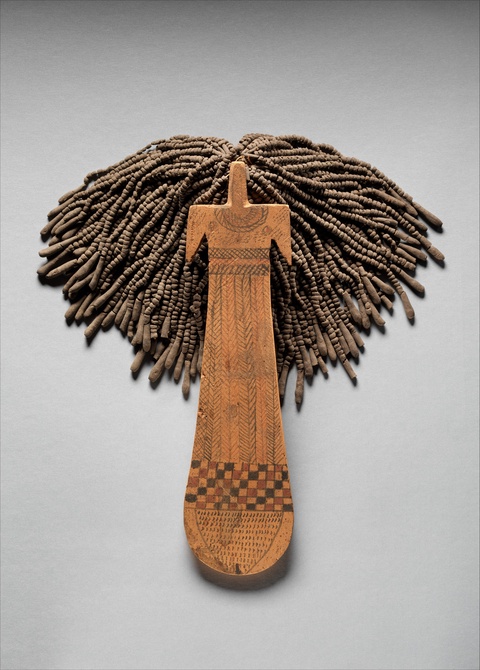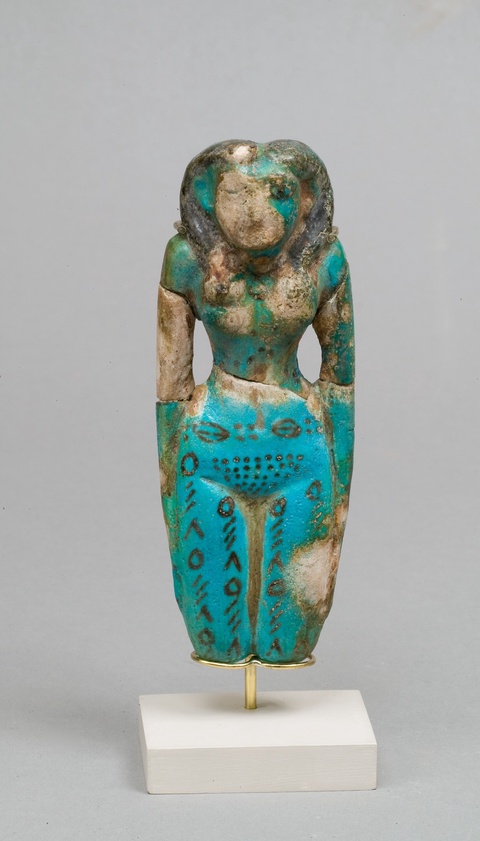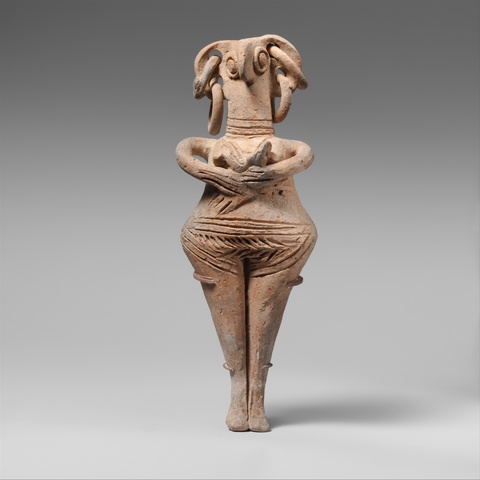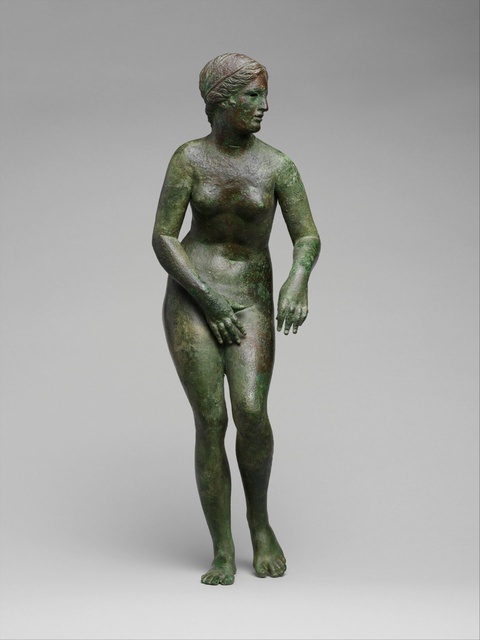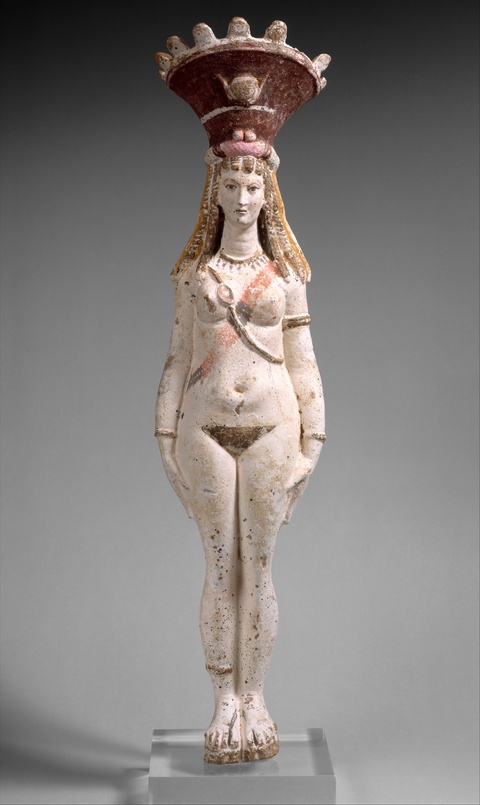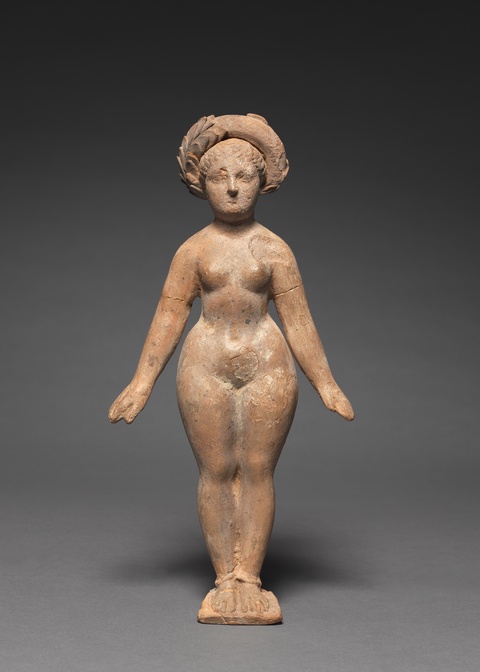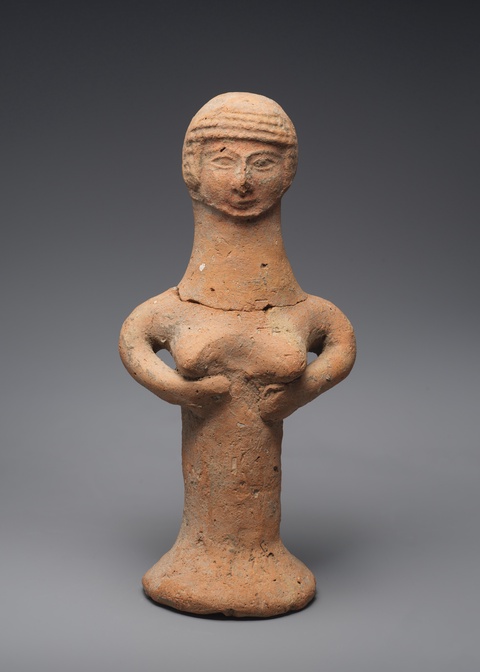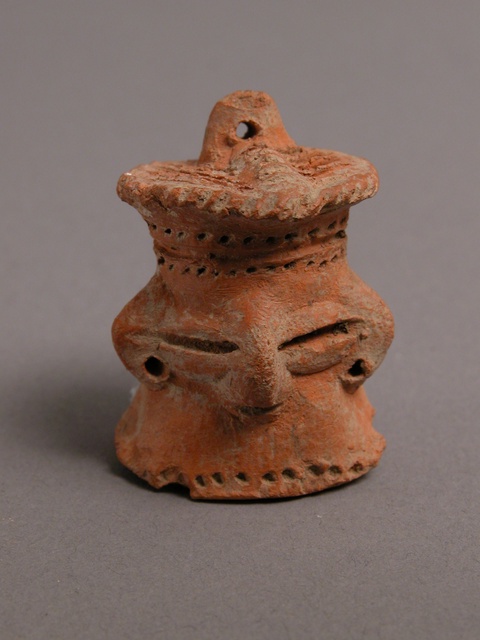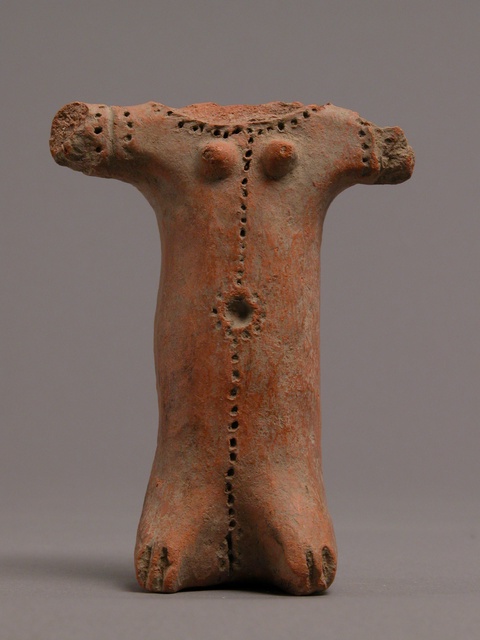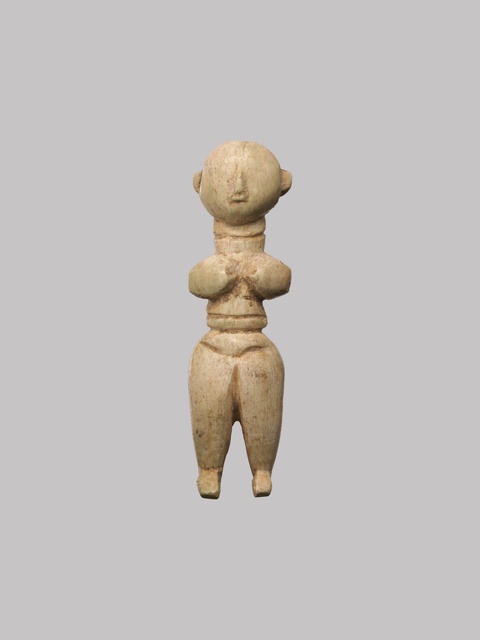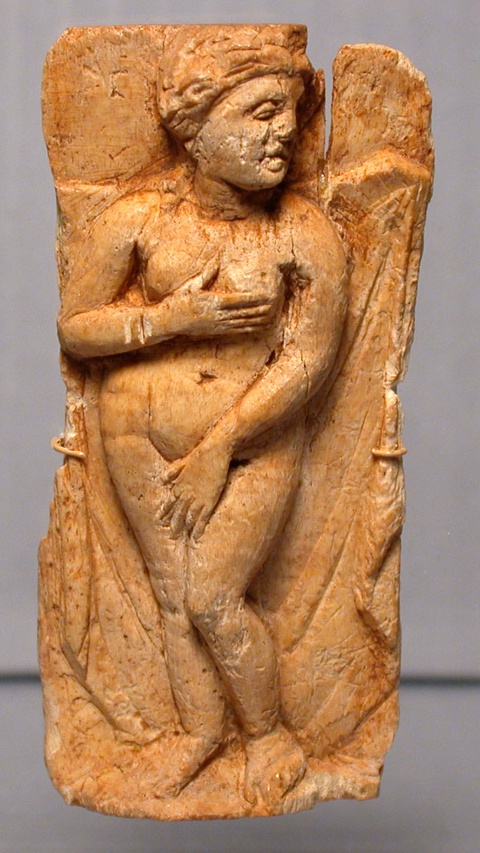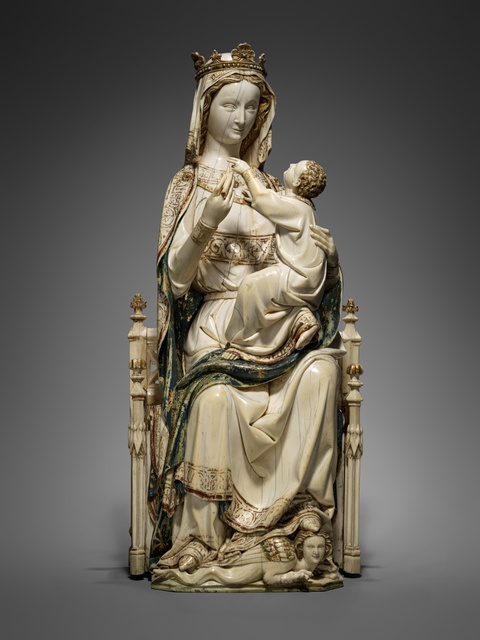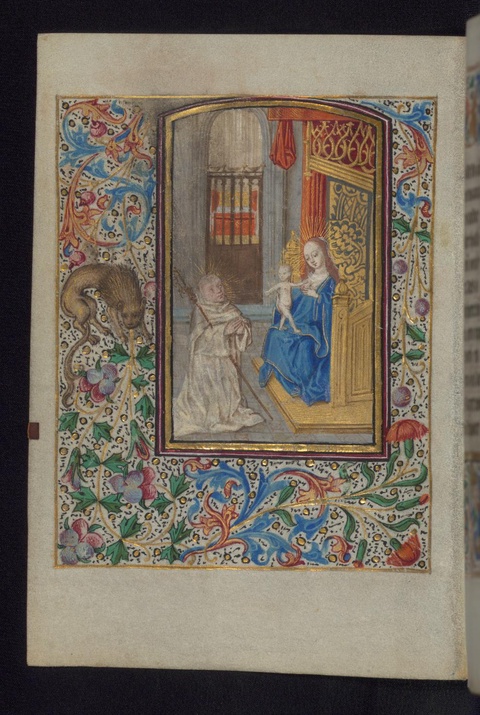Female Fertility Figurines in the Ancient Mediterranean
By Reina Gattuso•September 2022•13 Minute Read

Unknown, Seated female, ca. 5600–5000 BCE. Metropolitan Museum of Art. This figurine is small enough to fit in the palm of your hand.
Female fertility figurines are among the oldest art objects. Their curvaceous bodies represent motherhood, sexuality, and abundance. These statuettes were common in the ancient Mediterranean and surrounding areas, where they reflected goddess cults. Fertility figurines show how beliefs around sexuality and motherhood changed over time in this region, from erotic Stone Age sculptures to chaste Medieval depictions of the Virgin Mary.
Introduction
The oldest known representation of a human being is a small sculpture of a naked woman. Called “Venus of Hohle Fels,” the mammoth ivory figure is around 40,000 years old. Archaeologists have found similar sculptures at ancient sites around the world.
These figurines tend to be made of stone or clay, and are often small enough to fit in the palm of a hand. They are usually thick-hipped and -thighed, with large breasts, prominent vulvas, and rolls of fat. Across most pre-modern cultures, as in many societies today, female fatness evokes eroticism, maternal care, and abundance.1 2 On this basis, archaeologists and art historians assume that many of these voluptuous ancient images are fertility figurines.3 4
Many fertility figurines come from the ancient Mediterranean and surrounding cultures. This region gave rise to the belief systems of the ancient Levant, Greece, and Egypt, as well as the Abrahamic religions. Many of these ancient faiths had strong goddess cults, worshiping figures like the Egyptian Hathor and the Canaanite Asherah.
Mediterranean goddess cults evolved over thousands of years. So, too, did the forms of fertility figurines. Changes in Mediterranean depictions of divine femininity tell us about shifting cultural and regional ideas about the female body, sexuality, and motherhood. They also help us understand the continuities and discontinuities of fertility iconography within polytheistic and monotheistic religions.
The Origins of Mediterranean Mother Goddess Imagery
Sensuous figurines of fertile women were ubiquitous in the Stone and Bronze Age Mediterranean. The sculptures have different stylistic conventions. However, they share an emphasis on secondary sexual characteristics, demonstrating both eroticism and motherhood.
Stone Age Fertility Figurines
A seated pose was common in fertility figurines made in Mesopotamia and the Mediterranean region for thousands of years. The arms typically curve under the chest to emphasize the breasts. This clay figurine from the 6th millennium BCE is from the Halaf farming culture in Mesopotamia and Syria.
Artists in the Cyclades Islands carved figurines in the same hands-under-breasts position in the 5th millennium BCE. The artist stylized this figure using conventions like folds of belly and leg fat, probably to indicate abundance.
This figure, from the 3rd millennium BCE in Anatolia, is even more stylized. It’s difficult to recognize her as a woman at all. Art historians determined she is a fertility figure by comparing her to similarly shaped icons that more clearly represent women.5
Scholars argue that these artists chose a more abstract form to streamline production. They omitted details while emphasizing the figures’ culturally feminized attributes to make them easily recognizable.6
Fertility Magic in Ancient Egypt
Ancient Egyptians believed that the dead would be reborn in the afterlife through sexual reproduction. These fertility figurines from the 2nd millennium BCE were placed in tombs to aid the deceased.7
This wood example from about 2,000 BCE has a keyhole-shaped body with exaggerated labia and pubic hair. While Egyptologists call this kind of figure a “paddle doll,” it’s a burial object, not a toy.8
Some art historians theorize that paddle dolls represented sacred khener dancers, who were devotees of the Egyptian fertility goddess Hathor.9 They may have also doubled as musical instruments: when shaken, the beads of her hair make a percussive sound.10
This figure, also a burial object, is made of faience ceramic, which Egyptians thought had special powers. The distinctive breasts and thick thighs are similar to those of the Halaf figure. Ancient Egyptians associated her hairstyle with the goddess Hathor.11
Astarte and Aphrodite as Syncretic Figures
By the first millennium BCE, several interrelated goddesses of love, fertility, and motherhood emerged in the Mediterranean, including the Phoenician Astarte and Greek Aphrodite. Over time, as the cults of Aphrodite and Astarte traveled, the goddess’s representations sometimes merged with each other or with other local goddesses in a process of syncretization.
Astarte, Erotic Goddess of the Ancient Phoenicians
Historians theorize that the seafaring Phoenecians spread Astarte’s cult across the Mediterranean region. The Greek island of Cyprus was a particular crossroads.
The above small terracotta statue from Cyprus may represent a local mother goddess from Cyprus. By the 7th century BCE, around the time artists made the below figurine, Astarte’s cult had come to Cyprus. This terracotta figurine of a woman wearing lavish adornments probably represents a worshiper or attendant of Astarte.12
Astarte’s cult also traveled to Egypt, where, in the first century BCE, we see a representation of Astarte taking on attributes of Isis, the powerful Egyptian mother goddess.
The Many Travels of Aphrodite
In Greek mythology, Aphrodite was born on the shores of Cyprus.13 Her iconography was undoubtedly influenced by Astarte, then merged with other goddesses, including the Roman Venus.
This bronze copy of a famous Aphrodite statue contrasts with earlier, proud displays of exaggerated vulvas. In the last few centuries BCE, some Greek artists began to depict Aphrodite covering her vulva and breasts in what art historians call the “Venus pudica” pose.14 The pose simultaneously covers and emphasizes the vulva. Depending on the context, scholars interpret it as a gesture of shame, which artists sometimes playfully reimagine as an allusion to masturbation.15 16 17
In Roman Egypt, Aphrodite syncretized with the powerful mother goddess Isis. Isis-Aphrodite embodied the former’s maternal might and the latter’s erotic intensity.18
Greek deities spread as far as the Gandharan region of what is now Pakistan alongside the army of Alexander the Great. There, they combined with local Hindu, Buddhist, and ancient Iranian deities.
The Gandharan region already had a rich tradition of fertility figurines, including lush depictions of nature spirits, or yakshinis. This terracotta figurine’s smooth, wide hips and hair wreath evoke Greek sculptures of Aphrodite.19
Fertility Figurines And Monotheism
Most monotheistic religions evolved from polytheistic traditions. The monotheistic Abrahamic faiths—Judaism, Christianity, and Islam—eventually displaced earlier polytheistic traditions among most Mediterranean peoples. This dramatically altered representations of divine femininity.
Judaism
Reverence for fertility goddesses likely existed alongside the development of monotheism among the ancient Israelites.
Archaeologists have found many figurines like this in the ancient kingdom of Judah. Her form is similar to female fertility figurines from the region.
Archaeologists think people of the time associated figurines like this with the Canaanite goddess Asherah, related to Astarte.20 21 The Bible refers to representations of the goddess, suggesting that everyday people may have practiced folk fertility traditions alongside monotheism.22
Christianity
Archaeologists found these figurine fragments, dated from the 4th to 7th century CE, in a Coptic Christian home in Egypt.
The figure’s shape echoes the Asherah figure and other fertility figurines. Art historians believe that the home’s inhabitants may have used these figurines for fertility purposes. The figurines seem to have been deliberately destroyed, though scholars don’t know why.23
Islam
Most ancient Arabs, like other peoples in adjoining areas who became Muslim, were polytheistic.24
This striking 3rd or 2nd millennium BCE stone figurine is from the southwestern Arabian peninsula. The artist carved her with a blocklike form, using indentations to indicate breasts, mons, curvaceous thighs, and rolls of belly fat. She emphasizes her breasts with her hands.
Archaeologists excavated this carved bone figurine alongside artifacts of the early Islamic period from Nishapur, Iran. Her pronounced breasts, belly, and mons tie her to the fertility figurine tradition, many examples of which have been found in Central Asia. We don’t know if the figurine is an artifact from a previous era, if local Muslim people used it as part of a folk fertility practice, or if it was a toy.25
Fertility Iconography and the Virgin Mary
Unlike earlier, polytheistic religions of the region, which included many powerful female divinities, Christianity has a male savior figure and central patriarchal divinity. But the Virgin Mary is one of the most popular images of sacred femininity in the contemporary Mediterranean, particularly for Christians.
Christian depictions of Mary typically emphasize her virginity as well as her motherhood, in contrast to the eroticism of many ancient fertility goddess depictions. Feminists have argued that the Roman Catholic Church uses images of Mary to perpetuate patriarchal double standards of sexual purity.26 Yet images of Mary often also have iconography that visually connects her to the fertility figurine tradition.
Modest Goddesses in the Mediterranean
The Venus pudica pose, such as in this Byzantine panel, evoked the idea of modesty in depictions of divine femininity.
Mary is typically depicted as clothed, maternal, and chaste. Images of Mary holding the infant Jesus, such as in this Coptic tapestry, evoke the iconography of earlier female divinities. We can compare the sculpture of a seated Mary to the ancient Egyptian amulet of Isis nursing the infant Horus, or “Isis Lactans,” both below.27 28

The Fertile Virgin
Medieval and Renaissance Roman Catholic art included representations of the physical and spiritual power of Mary’s mothering body. In the story of Saint Bernard, the 12th-century monk prayed to a Virgin Mary statue. She came to life, squirting breast milk into his mouth and thus granting him the gift of divine eloquence.
The Lactation of Saint Bernard was a common theme in medieval Catholic art.29 Representations of Mary’s breasts became rarer after the Renaissance. Some scholars argue that because the printing press made secular images of the body, such as pornography and medical texts, more accessble, the public saw it as less sacred.30 31
Contemporary Christian art features very few depictions of the Virgin Mary’s naked body.32 But many worshippers, particularly in folk practice, continue to associate her with fertility.33 34
Joseph Stella (American, born Italy), The Virgin, 1926. Brooklyn Museum of Art. This painting of the Virgin Mary reflects Stella's turn toward religious and Southern Italian motifs after traveling in Europe.
Modernist painter Joseph Stella drew on Southern Italian folk art and popular Virgin Mary shrines to produce this colorful 1926 painting. Fruits nimbus Mary’s head, vines climb up her arms, and a ring of flowers marks Mary’s womb, assuring the viewer that—across time and space—human beings continue to recognize the uncanny power of women’s bodies to manifest abundance.
Reina Gattuso is a content writer on the Curationist team, and an independent journalist covering gender and sexuality, arts and culture, and food. Her journalism connects analysis of structural inequality to everyday stories of community, creativity, and care. Her work has appeared at Atlas Obscura, The Washington Post, Teen Vogue, The Lily, POPSUGAR, and more. Reina has an MA in Arts and Aesthetics (cinema, performance, and visual studies) from Jawaharlal Nehru University in New Delhi, India, where her research focused on sexuality in Hindi film. She writes and teaches writing to high school students in New York City.
Suggested Readings
Clark, Kenneth. The Nude: A Study in Ideal Form. Princeton University Press, 1956. Internet Archive, https://archive.org/details/nudestudyinideal00clar/mode/2up.
“The fertile goddess.” Brooklyn Museum, www.brooklynmuseum.org/opencollection/exhibitions/3179.
Hoerr, Caitlin. “Blood and Milk, Science and Culture: The Virgin as a Nursing Mother.” National Museum of Women in the Arts, 4 Feb. 2015, https://nmwa.org/blog/artist-spotlight/blood-and-milk-science-and-culture-the-virgin-as-a-nursing-mother/.
Lee, Dorothy Ann. “How the cult of Virgin Mary turned a symbol of female authority into a tool of patriarchy.” The Conversation, 22 Dec. 2019, theconversation.com/how-the-cult-of-virgin-mary-turned-a-symbol-of-female-authority-into-a-tool-of-patriarchy-127806.
Otele, Olivette. African Europeans: An Untold History. Hurst 2020.
Citations
Swami, Viren. “Women’s idealised bodies have changed dramatically over time – but are standards becoming more unattainable?” The Conversation, 13 Sept. 2016, theconversation.com/womens-idealised-bodies-have-changed-dramatically-over-time-but-are-standards-becoming-more-unattainable-64936. Accessed 17 March 2022.
Fedorak, Shirley A. “Body Image.” Global Issues. University of Toronto Press, 2013, pp. 71-83.
“Seated Female.” The Metropolitan Museum of Art, www.metmuseum.org/art/collection/search/327066. Accessed 17 March 2022.
“Female Fertility (?) Figure.” The Metropolitan Museum of Art, www.metmuseum.org/art/collection/search/449448. Accessed 17 March 2022.
“Figure.” Brooklyn Museum, www.brooklynmuseum.org/opencollection/objects/155572. Accessed 17 March 2022.
“Figure.”
“Egypt Reborn: Art for Eternity.” Brooklyn Museum, brooklynmuseum.org/opencollection/exhibitions/648. Accessed 17 March 2022.
“Paddle Doll.” Wikipedia, en.wikipedia.org/wiki/Paddle_doll. Accessed 17 March 2022.
Morris, Ellen F. “Paddle Dolls and Performance.” Journal of the American Research Center in Egypt, Vol. 47, 2011, pp. 71-103. JSTOR, www.jstor.org/stable/24555386. Accessed 17 March 2022.
“Paddle Doll.” The Metropolitan Museum of Art, https://www.metmuseum.org/art/collection/search/544216. Accessed 17 March 2022.
“Female Figure.” The Metropolitan Museum of Art, www.metmuseum.org/art/collection/search/544220. Accessed 17 March 2022.
“Terracotta Woman.” The Metropolitan Museum of Art, www.metmuseum.org/art/collection/search/241115. Accessed 17 March 2022.
Melby, Julie A. “The Birth of Aphrodite, or Venus Rising from the Froth of the Sea.” Graphic Arts, 15 Mar. 2012, www.princeton.edu/~graphicarts/2012/03/thebirthof_aphrodite.html. Accessed 17 March 2022.
“Bronze Statuette of Aphrodite.” The Metropolitan Museum of Art, www.metmuseum.org/art/collection/search/248658. Accessed 17 March 2022.
Salomon, Nanette. “The Venus Pudica: Uncovering Art History’s ‘Hidden Agendas’ and Pernicious Pedigrees.” Generations and Geographies in the Visual Arts: Feminist Readings, edited by Griselda Pollock, Taylor and Francis, 2005, 87-114. Accessed 5 May 2022.
Dennis, Kelly. “Playing With Herself: Feminine Sexuality and Aesthetic Indifference.” Solitary Pleasures: The Historical, Literary and Artistic Discourses of Autoeroticism, edited by Paula Bennett and Vernon Rosario, Taylor and Francis, 2020, 49-74. Accessed 5 May 2022.
Couzin, Robert. “Invented Traditions: Latin Terminology and the Writing of Art History.” The Journal of Art Historiography, December 2018. Google Books, https://www.google.com/books/edition/Invented_Traditions/SXmozQEACAAJ?hl=en. Accessed 5 May 2022.
“Figure of Isis-Aphrodite.” The Metropolitan Museum of Art, www.metmuseum.org/art/collection/search/544919. Accessed 17 March 2022.
Poster, Amy G. “Standing Female.” Indian Earth: 4,000 Years of Terracotta Art, The Brooklyn Museum, 1986.
“Nude Female Figure.” The Metropolitan Museum of Art, www.metmuseum.org/art/collection/search/323163. Accessed 17 March 2022.
“El (deity).” Wikipedia, en.wikipedia.org/wiki/El_(deity). Accessed 2 April 2022.
Downey, April Lynn. “Asherah.” World History Encyclopedia, 29 Sept. 2020, www.worldhistory.org/Asherah/. Accessed 17 March 2022.
“Head of a Female Figurine.” The Metropolitan Museum of Art, www.metmuseum.org/art/collection/search/478471. Accessed 17 March 2022.
Ryckmans, Jaques. “Arabian Religion.” Britannica, 24 Jan. 2022, www.britannica.com/topic/Arabian-religion. Accessed 17 March 2022.
“Female Fertility (?) Figure.” The Metropolitan Museum of Art, www.metmuseum.org/art/collection/search/449448. Accessed 17 March 2022.
Lee, Dorothy Ann. “How the cult of Virgin Mary turned a symbol of female authority into a tool of patriarchy.” The Conversation, 22 Dec. 2019, theconversation.com/how-the-cult-of-virgin-mary-turned-a-symbol-of-female-authority-into-a-tool-of-patriarchy-127806. Accessed 17 March 2022.
Tyldesley, Joyce. “Isis.” Britannica, www.britannica.com/topic/Isis-Egyptian-goddess. Accessed 17 March 2022.
Higgins, Sabrina. “Divine Mothers: The Influence of Isis on the Virgin Mary in Egyptian Lactans-Iconography.” Journal of the Canadian Society for Coptic Studies, vol. 3, 2012, pp. 71 - 90. https://lockwoodonlinejournals.com/index.php/jcscs/article/view/99. Accessed 5 May 2022.
Hoerr, Caitlin. “Blood and Milk, Science and Culture: The Virgin as a Nursing Mother.” National Museum of Women in the Arts, 4 Feb. 2015, nmwa.org/blog/artist-spotlight/blood-and-milk-science-and-culture-the-virgin-as-a-nursing-mother/. Accessed 17 March 2022.
Kosloski, Philip. “Why is the Virgin Mary Feeding St. Bernard With Breast Milk?" Aleteia, 20 Aug. 2019, aleteia.org/2019/08/20/why-is-the-virgin-mary-feeding-st-bernard-with-breast-milk/. Accessed 17 March 2022.
Van Esterik, Penny. “Book Revew.” Culture, Health, and Sexuality, vol. 11, no. 4, May 2009. JSTOR, www.jstor.org/stable/27784464. Accessed 17 March 2022.
Gibson, David. “Christmas’ missing icon: Mary breastfeeding Jesus.” The Washington Post, 10 Dec. 2012, www.washingtonpost.com/national/on-faith/christmas-missing-icon-mary-breastfeeding-jesus/2012/12/10/b9a25316-4313-11e2-8c8f-fbebf7ccab4e_story.html. Accessed 17 March 2022.
Håland, Evy Johanne. “The Dormition of the Virgin Mary on the Island of Tinos: A Performance of Gendered Values in Greece." Journal of Religious History, vol. 36, no. 1, March 2012. https://www.researchgate.net/profile/Evy-Haland/publication/263751053_The_Dormition_of_the_Virgin_Mary_on_the_Island_of_Tinos_A_Performance_of_Gendered_Values_in_Greece/links/5deea94792851c8364704f64/The-Dormition-of-the-Virgin-Mary-on-the-Island-of-Tinos-A-Performance-of-Gendered-Values-in-Greece.pdf. Accessed 5 May 2022.
Starr Sered, Susan. “Rachel's Tomb and the Milk Grotto of the Virgin Mary: Two Women's Shrines in Bethlehem.” Journal of Feminist Studies in Religion, vol. 2, no. 2, fall 1986. JSTOR, https://www.jstor.org/stable/25002038. Accessed 5 May 2022.
Reina Gattuso is a content writer on the Curationist team, and an independent journalist covering gender and sexuality, arts and culture, and food. Her journalism connects analysis of structural inequality to everyday stories of community, creativity, and care. Her work has appeared at Atlas Obscura, The Washington Post, Teen Vogue, The Lily, POPSUGAR, and more. Reina has an MA in Arts and Aesthetics (cinema, performance, and visual studies) from Jawaharlal Nehru University in New Delhi, India, where her research focused on sexuality in Hindi film. She writes and teaches writing to high school students in New York City.
